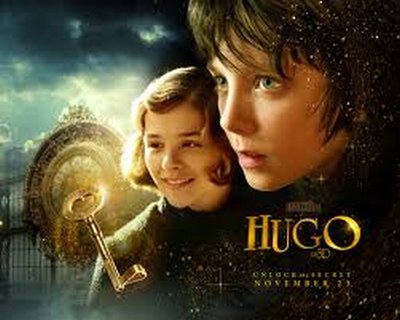Hugo (3D) (Martin Scorsese, 2011): USA
Reviewed by Kris Mendes at the Santa Barbara International Film Festival, Sunday, January 29, 2012.
A new Martin Scorsese film that doesn’t involve shoot outs or graphic violence? In 3D? With children in the central characters? Say it isn’t so! Has Scorsese sold out? To watch a Scorsese film rated PG was not something that many of his fans have been looking forward to, but this is what they get: his personal ode to film and filmmaking. To have it be on 3D was not a gimmick but his way to lure audiences into something that is more than just a kids’ popcorn film. 3D is used as a tool to show how film has progressed since the day it was invented, from it being short documentarty-style snippets of life, like a train going by, to what they are now, special effects laden 3D spectacles which serve as storytelling tools. Scorsese uses 3D to bring the audience into his film about, well, film.
The movie stars newcomer Asa Butterfield as the titular character, who works at a train station fixing and making sure the clocks are on time in 1930s Paris. Hugo is always watching out for the station’s inspector, played by Sasha Baron Cohen, who is in the constant look out for homeless kids to send them to the orphanage. Cohen and his constant chasing of Hugo, provides most of the comical side of the movie. Besides taking care of the clocks in the station, after his uncle has gone missing, Hugo is trying to fix an ‘automaton’ –a small robot created to do simple tasks, like writing- his father had found before his death that they were trying to fix together. When the young protagonist gets caught stealing by a toy shop owner, the toy shop owner’s granddaughter, Isabelle, (played by Chloe Grace Moretz), decides to help him. What follows is the relationship the boy and the old man develop, the adventure Hugo and Isabelle, and the secrets that the old man is hiding from the world and from himself.
Cinema has evolved since its invention – it has, for better or for worse, transformed from a medium of wonder to a much more standard and predictable mindless fare. It has become more about the special effects and gimmicks than the story, and what Scosese did with Hugo is use the 3D gimmick to lure and audience into a film that is about the love of film for what it used to be, about a story, about characters, by using a real person in a fictional setting. Ben Kingsley’s character, Georges Méliès, is a real man, who, like in the film, faded into obscurity but was luckily found and his contributions to cinema recognized. How many good artists and movies are being lost in the sea of Hollywood films backed by studios? Watching Kingsley’s performance as he is creating movies in the flashback scenes, to see the passion and love he has for them, to watch how movies used to be made and all the extra work that went into creating sets and special effects, will hopefully want to make the younger members of the audience want to watch those old films, surely one of Scorsese’s goals in the film.
If 3D is not your cup of tea, or there are reservations about this not being the Scorsese of past, try to give it a chance. Suspension of disbelief is something required of all moviegoers. The kids in the movie are great, but it’s Kingsley’s performance that elevates the movie from average and into must-watch status. This is a movie for movie lovers of all ages, don’t let the rating fool you. And Borat is in it as well! (a treat for all the Borat fans).
Hopefully, now that Hugo has been nominated, and remained in theatres steadily since its release, more people will go see it, and experience this Trojan horse of a film in a world where film is being replaced by digital.
About this entry
You’re currently reading “Hugo (3D) (Martin Scorsese, 2011): USA,” an entry on Student Film Reviews
- Published:
- 02.13.12 / 4pm
- Category:
- Films, Santa Barbara Film Festival 2012

2 Comments
Jump to comment form | comments rss [?] | trackback uri [?]